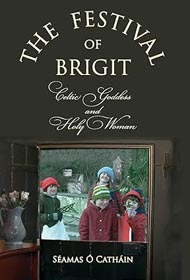The Festival of Brigit
Celtic Goddess and Holy Woman
Séamas Ó Catháin
Phaeton Publishing Limited 1995
updated and extended version 2023
First published in 1995, and now updated, extended, and reissued to coincide with Ireland's new national holiday.
Professor Séamas Ó Catháin's monumental study of the Festival of Brigit - Imbolc, February 1st -
updated, extended, and published in a new edition, in honour of Ireland's newest national holiday.
Brigit was one of three great saints of early Irish Christianity, alongside Patrick, the patron saint of Ireland,
and Colm Cille (Columba), Irish colonizer of Scotland and founder of Iona. By tradition, Saints' Day festivals and
other Holy Days were celebrated over twenty-four hours, starting on the eve of the feast and continuing through
the night and through the following day. Thus the Festival of Brigit includes Oíche Fhéile Bríde (St Brigit's Eve)
and Lá Fhéile Bríde (St Brigit's Day) - on 31st January and 1st February respectively.
However, these are not the oldest names associated with this festival in Irish tradition, for in earlier pre-Christian
times it was called Imbolc - a word whose basic meaning has much to do with milking and milk-production.
This book views Brigit - the Celtic goddess and the Christian-era Saint - not merely in an Irish context,
but also in an international and western European context. It attempts to uncover the motivation of previous
generations, both within Ireland and beyond it, in sustaining and preserving ancient practices and beliefs,
and highlights how fundamentally important folk culture is to our understanding of the past.
"... A fascinating read, showing the complexity and strength of oral
traditions and the very strong links betweeen belief and material
culture, a link that archaeologists are sometimes inclined to ignore as
opposed to trying to come to terms with its complexity, as Professor
Ó Catháin has done succesfully here."
- Archaeology Ireland.
"... this is an interesting and stimulating book, fascinating in its detail..."
- Edinburgh University Press.
"... some very interesting aspects of the celebration of Brigit emerge
some of which the author considers, others of which will prompt
investigation by other researchers. The extent to which this volume
can excite, by its citation of sources, and its bringing together of
analogues, is a tribute to the author."
- Nordic Yearbook of Folklore.
(The text above comes from the back of the book)


